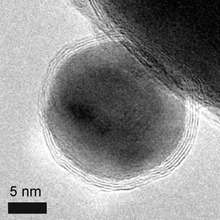Nanochemistry

Nanochemistry or Nanotechnology are related with the production and the reactions of nanoparticles, nanostructures and their compounds. It is concerned with the unique properties associated with assemblies of atoms or molecules on a scale between that of the individual building blocks and the bulk material (from 1 to 1000 nm[2]). At this level, quantum effects can be significant, and also new ways of carrying out chemical reactions become possible.
This science use methodologies from the synthetic chemistry and the materials chemistry to obtain nanomaterials with specific sizes, shapes, surface properties, defects, self-assembly properties, designed to accomplish specific functions and uses.[3] Nanomaterials can be created from virtually any material, such as metals, semiconductors and polymers, both in their amorphous and crystalline forms.
Nanochemical methods can be used to create carbon nanomaterials such as carbon nanotubes (CNT), graphene and fullerenes which have gained attention in recent years due to their remarkable mechanical and electrical properties.
Applications
| Part of a series of articles on |
| Molecular nanotechnology |
|---|
|
There are a wide range applications of nanochemistry fabrication, such as semi-conductors electronics, advanced composite materials (e.g. carbon nanotube polymers), colloidal particles (e.g. in paint products), medicine etc. Nanochemistry uses semi-conductors that only conduct electricity in specific conditions.
There is evidence certain nanoparticles of silver are useful to inhibit some viruses and bacteria.[4]
Examples
Nanochemistry can be used to build high-tech products for clean energy, catalysis, biosensors, biomedicine, etc.
Nanochemistry is also used to make windows that clean themselves, along with bicycles that are 1000 times stronger than steel but lighter than metal ones. The most productive piece of Nanochemistry is Carbon Nanotubes which are very dense and light when made into materials such as bicycles. Nanochemistry could be very useful in the future.
Selected books
- J.W. Steed, D.R. Turner, K. Wallace Core Concepts in Supramolecular Chemistry and Nanochemistry (Wiley, 2007) 315p. ISBN 978-0-470-85867-7
- Brechignac C., Houdy P., Lahmani M. (Eds.) Nanomaterials and Nanochemistry (Springer, 2007) 748p. ISBN 978-3-540-72993-8
- H. Watarai, N. Teramae, T. Sawada Interfacial Nanochemistry: Molecular Science and Engineering at Liquid-Liquid Interfaces (Nanostructure Science and Technology) 2005. 321p. ISBN 978-0-387-27541-3
- Ozin G., Arsenault A.C., Cademartiri L. Nanochemistry: A Chemical Approach to Nanomaterials 2nd Eds. (Royal Society of Chemistry, 2008) 820p. ISBN 978-1847558954
- Kenneth J. Klabunde; Ryan M. Richards, eds. (2009). Nanoscale Materials in Chemistry (2nd ed.). Wiley. ISBN 978-0-470-22270-6.
References
- ↑ Grass, R. N.; Athanassiou, E. K.; Stark, W. J. (2007). "Covalently Functionalized Cobalt Nanoparticles as a Platform for Magnetic Separations in Organic Synthesis". Angewandte Chemie International Edition. 46 (26): 4909. doi:10.1002/anie.200700613.
- ↑ Concepts of nanochemistry, Cademartiri, Ludovico and Ozin, Goeffrey A. Wiley-VCH 2009 ISBN 978-3-527-32626-6
- ↑ Nanochemistry: What Is Next?, Ozin, Geoffrey A. and Cademartiri, Ludovico, 2009 Wiley-VCH Verlag, Weinheim small 2009, 5, No. 11, 1240–1244
- ↑ Xiang, Dong-xi; Qian Chen; Lin Pang; Cong-long Zheng (17 September 2011). "Inhibitory effects of silver nanoparticles on H1N1 influenza A virus in vitro". Journal of Virological Methods. doi:10.1016/j.jviromet.2011.09.003. ISSN 0166-0934.